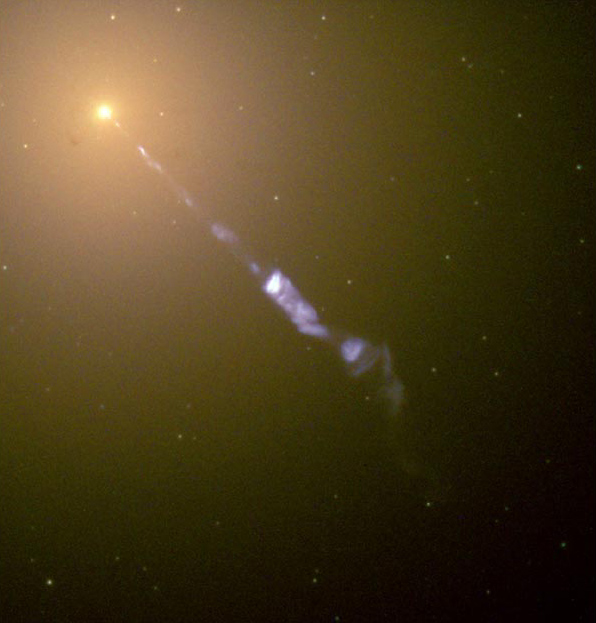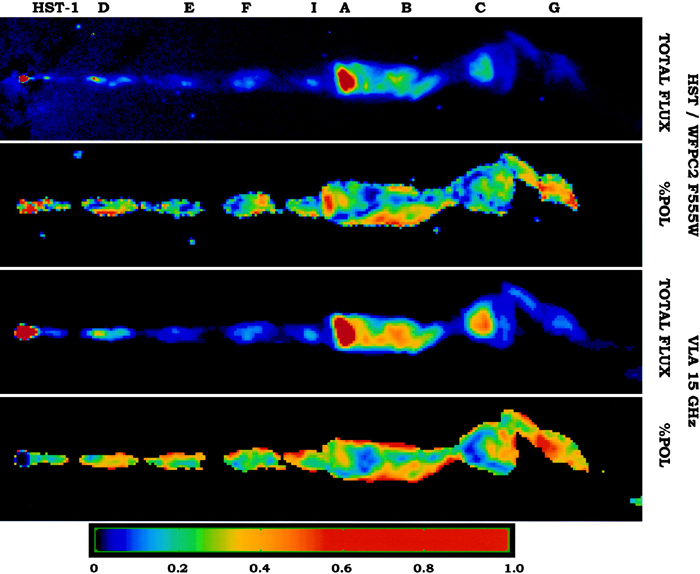
The most dominant and massive galaxy in the Virgo cluster is M87. This powerful elliptical galaxy of over 1 trillion stars is enormous by all galactic standards having a remarkable diameter of over one million light years. Its perimeter is remarkable for the presence of thousands of globular clusters visible as fuzzy dots from a distance of 52 million light years. M87 lies at the center of the Virgo galaxy cluster and is responsible for much of the energy output of the Virgo cluster in the form of X-ray and radio wave emission. M87 is best known as a giant radio galaxy possessing a famous 6500 light year long unidirectional jet arising from its nucleus. The jet is highly visible at multiple wavelengths including radio, optical, and X-rays.
The first observation of a nuclear jet was made in 1918 from photographs of M87 taken at the Lick observatory. Described at the time as "a curious straight ray", its importance wasn't known until much later when M87 was found to coincide with the radio source Virgo A. It became clear that many galaxies with active galactic nuclei such as seyferts, quasars, and radio galaxies often show jet phenomenon. However the jet of M87 has special significance as no other jet yet observed has emission even remotely as bright as M87. M87's radio jet powers enormous radio lobes several times the optical size of the galaxy.
M87's famous jet has been observed for longer than a decade at multiple wavelengths. High resolution observations by the HST and VLA have elucidated some of the detailed structure of the jet. The jet arises from a rotating disk of stars and matter known as an accretion disk which gives up mass to what astronomers believe is the most massive black hole known in our universe so far. The largest of all known black holes has a mass of 3 billion suns packed into an area the size of our solar system. As material from the accretion disk falls into the massive black hole, mass is converted to energy through an extremely efficient process (conversion is greater than 50%). The jet is produced as heated gases are pulled away and propelled from the black hole along the axis of rotation in a well collimated narrow jet. The light we see (and the radio emission) arises from high energy electrons which spiral around the strong magnetic field of the jet, producing a specific form of radiation known as Synchrotron radiation. This type of radiation is typically generated by high speed charged particles accelerated in a magnetic field.
The knots or "brightened regions" within the jet represent regions where the electrons are accelerated to higher energies for reasons that are unclear. The individual knots can represent areas as small as 10 light years across. The structure of the jet and its component knots is complex showing changes in the magnetic field direction at different distances from the nucleus. The jet is formed within a few tenths of a light year from the core of the galaxy. The jet opens widely at an angle of 60 degrees but is quickly collimated to within 6 degrees within a few light years of the nucleus.

HST image of the 6500 light year jet at optical wavelengths

Images of M87's jet at various wavelengths including X-ray and radio wave